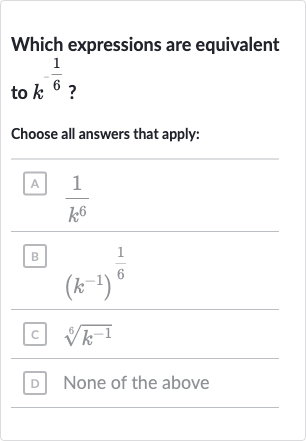Full solution
Q. Which expressions are equivalent to ?Choose all answers that apply:A B c D None of the above
- Understand given expression: Understand the given expression.The given expression is , which means we are looking for expressions that represent the sixth root of or the reciprocal of the sixth power of .
- Analyze option A: Analyze option A.Option A is . This is not equivalent to because it represents the reciprocal of raised to the sixth power, not the sixth root of .
- Analyze option B: Analyze option B.Option B is . This expression represents the sixth root of raised to the negative first power, which is equivalent to the sixth root of . Therefore, option B is equivalent to .
- Analyze option C: Analyze option C.Option C is . This expression represents the sixth root of raised to the negative first power, which is equivalent to the sixth root of . Therefore, option C is equivalent to .
- Analyze option D: Analyze option D.Option D states "None of the above," which is incorrect because we have found that options B and C are equivalent to .
More problems from Compare linear and exponential growth
QuestionGet tutor help
QuestionGet tutor help
QuestionGet tutor help
QuestionGet tutor help
QuestionGet tutor help
QuestionGet tutor help
QuestionGet tutor help

